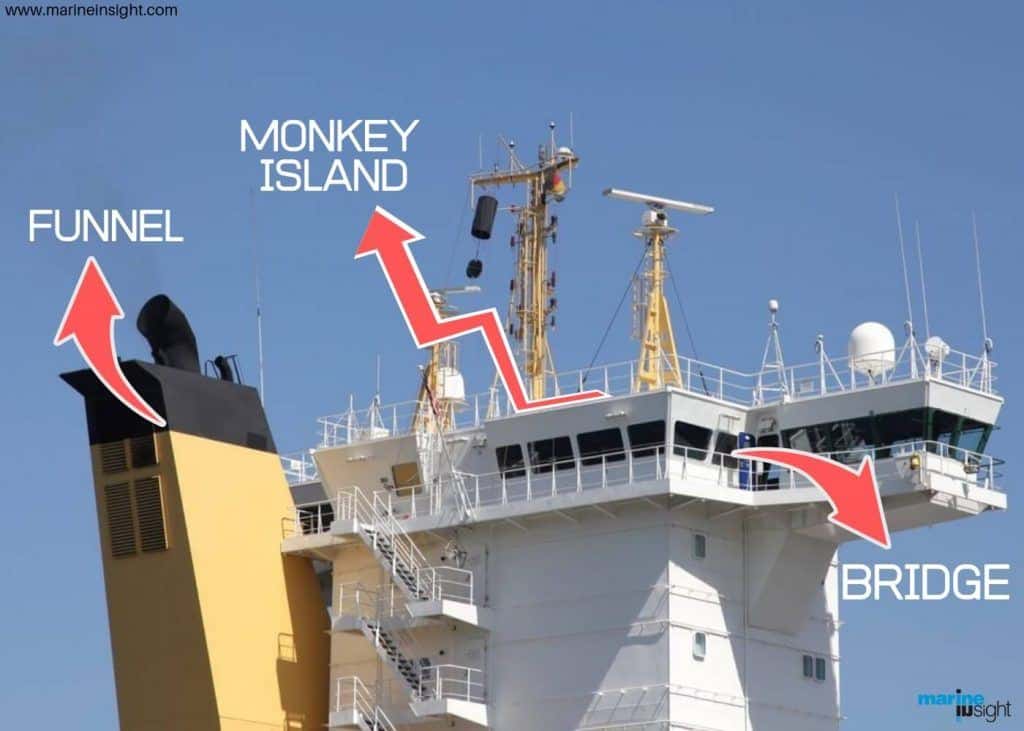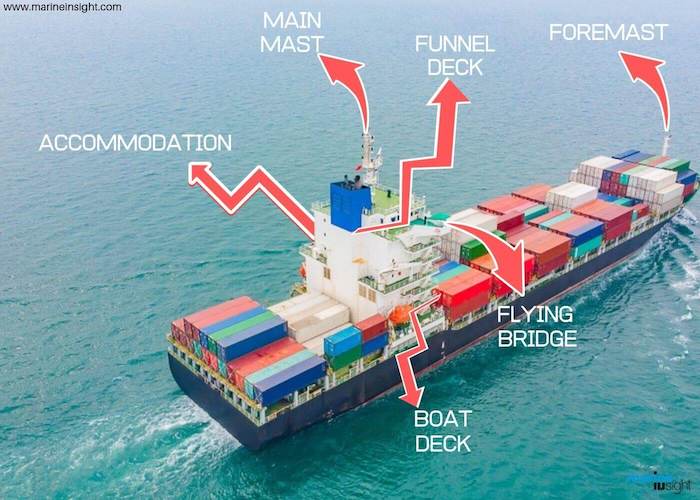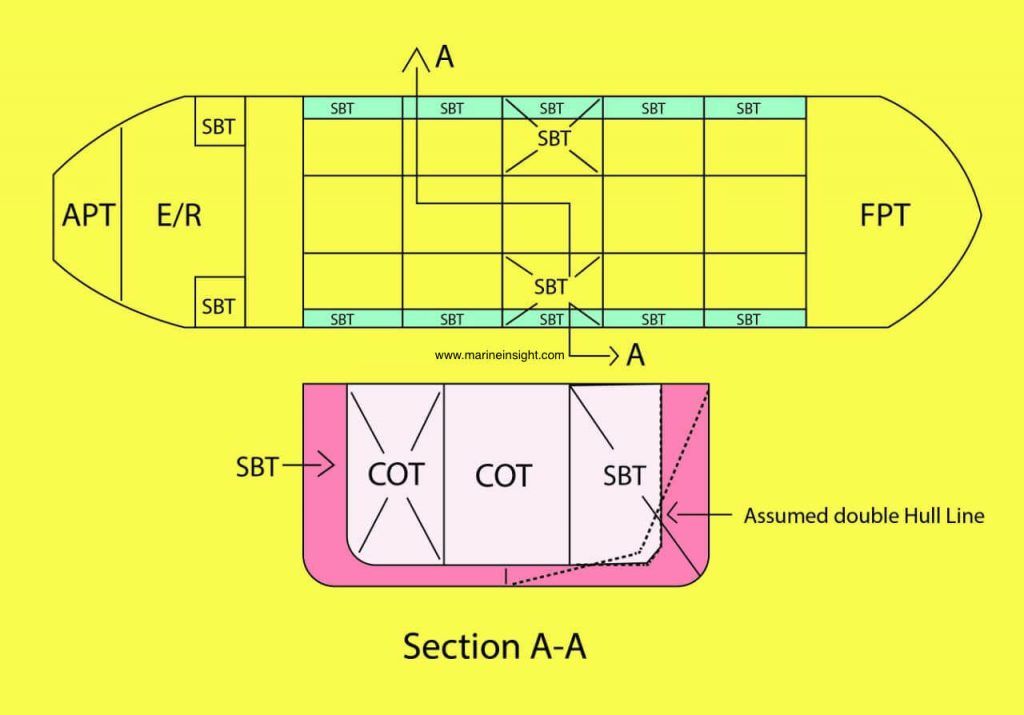Different Parts Of A Ship Explained
A ship is like a floating city having several different parts. However, we can’t imagine a ship without its three main parts which are: The Hull, an engine room and a navigation bridge.
A ship comprises of both visible as well as invisible parts. E.g. rudder, anchor, bow, keel, accommodation, propeller, mast, bridge, hatch coves and bow thrusters are some common visible parts whereas bulkheads, frames, cargo holds, hopper tank, double bottom, girders, cofferdams, side shell etc. are the invisible parts of a ship.
LATEST VIDEOS
To understand parts of a ship, one must have to go through some common terms.
The most forward part of a ship is called a Bow, the left-hand side of the ship is referred to as port whereas the right side is called starboard. Likewise, the front side is termed as forward and back side as astern.
Related Read: What’s The Importance Of Bulbous Bow Of Ships?
Now let us discuss some main parts which are common to all types of ships.
Monkey Island:
- Monkey Island is a sort of deck located at a topmost accessible height of the ship and just above the bridge
- This part of a ship is sometimes also referred to as a flying bridge and, in past, was used by the sailors for solar and stellar observations. It houses a magnetic compass.
- It is an integral part of ship and houses driving units such as VDR capsule, AIS Tx/Rx antennae, Radar scanner(s) attached to the radar mast, Sat C/F77 Tx/Rx antennae, communication equipment gear, various halyards connected to the yardarm to hoist flags, weather vane, and the masts leading up to the ‘Christmas Tree’ (navigation lights) and to the ship’s aft whistle.
Related Read: What is Monkey Island on Ships?
Bridge:
- The ship’s bridge is the commanding station of a ship. It controls the ship movement through its navigational equipment.
- It controls important deck machinery, main engine and ship’s navigation system.
- Functions that are usually performed on the ship bridge are: controls the ship’s speed and direction (navigation), monitor weather and sea conditions, navigating and fixing the position of the ship, and facilitating internal as well as external communication
Funnel:
- A Funnel or Stacks is a chimney on a vessel used to discharge engine and boiler smoke.
- Lifting of the exhaust gasses, clear from the deck, is the constitutional purpose of the Funnel.

Accommodation:
- The accommodation area is the house for crews and lives. It has all the amenities along with offices, gym, crew cabins, hospital, salon, recreation room, common rooms, laundry and galley.
- It is a key part of the ship and consists of the garbage disposal system, fresh water system, sewage treatment plant, refrigeration system (domestic) and air conditioning for accommodation block.
- It is a necessary part of a ship, and facilitates space for relaxing, medical facility and food courts.
Related Read: 10 Points To Check While Inspecting Accommodation Areas On Ships
Funnel Deck:
- Funnel releases exhaust gases into the atmosphere from engine exhaust room of the ship. It has a similar function to chimneys in factories.
- Nowadays extra care has been taken in discharging shoot from the funnel to preserve the atmosphere from pollution.
- These funnels are never installed straight but inclined at a certain angle toward the aft so that the flue gases will not cause hindrance to the deck and navigation bridge of the ship
Boat Deck:
- Ship hull structure is covered by the deck floor. There can be multiple decks or deck sections on a ship. The deck at the top which bears maximum exposure to weather is referred to as the main deck or weather deck.
- On the basis of the position of a ship’s deck, decks are of six main types; main deck, poop deck, upper deck, lowers deck, weather deck and foredeck.
- The boat deck’s main function is holding the hull structure and providing floor to work, and standing and guard them against outside weather.

Mast:
- The mast is a rangy spar arrangement which is elevated more or less vertically to the Centre line of a ship.
- It has several purposes which include carrying derricks and also giving fundamental height to the navigation light, salient yards, radio or radar aerials and scanners.
Flying Bridge:
- It is an extended area on top of a weather deck or an open area of the superstructure which provides an unobstructed view of the fwd and aft along with the sides of the vessel to the navigational officers.
- It also serves as an operating station for the officer and crew of the watch.
- It also contains a duplicate set of controls which is of vital importance for the master, ship’s officers and pilot for berthing and unberthing of the vessel.
Stem:
- Front-most part of the boat or ship’s bow is termed as Stem of the ship.
- The keel itself is extended up to gunwale to form the curved edge called stem of the ship.
- These stems can be of two styles viz. raked and plumb stems, where former is inclined at some angle to the waterline and later is perpendicular to the waterline.
Forecastle:
- The forecastle is one of the foremost parts of the ship of length less than 7% of total deck length.
- It was initially used in military vessels, in which the soldiers used forecastle to take defensive positions.
- But, today, forecastle serves many functions such as holding, anchoring and securing the major parts of the ship.
Foredeck:
- The foredeck is the forward part of a weather deck, between the superstructure and the foc’sle superstructure.
- Basically, it is a part of the vessel forward of the mast.

Bulbous Bow:
- It is a jut out bulb at the bow of the vessel just below the W/L.
- It cuts the water and tweaks the water flow around the hull, increasing the vessel’s speed, fuel efficiency and stability.
- 12-15% of better fuel efficiency is observed in the vessel with the bulbous bow.
- It also increases the buoyancy of the onward part of the vessel, which results in the reduction of pitching up to some extent.
Related Read: Types of Bow Designs used for Ships
Stern:
- The stern is aft end structure and designed to provide low resistance, high propulsion efficiency and avoid vibrations.
- It is the rearmost part of a ship which keeps the water out. Rudders and propellers are hanged to the stern.
- The stern can be shaped flat, canoe-like, tapered, sharp to serve the purpose of cutting the water in its way.
Related Read: Different Types Of Sterns Used For Ships

Poop Deck:
- It serves as a roof to the cabin constructed in the aft of the ship.
- It facilitates the captain and helmsman to supervise the entire working crew.
- But in modern ships, the poop decks are provided either in the centre of the ship or on the starboard.
Side Thrusters:
- These are somewhat like a propeller and fitted on either side of the bow of the ship.
- It helps in manoeuvring ship under slow speed in congested waters near ports or canals. These are also referred to as tunnel thruster.
- Side thrusters influence the total running cost of a ship to a greater extent. These are either hydraulically or electrically powered.
Rudder:
- Without steering, we can’t move a vehicle in the desired direction; so the propeller propels the ship and rudder steer the ship. The rudder is a flat hollow structure, housed in the aft of the propeller.
- It consists of following parts: rudder trunk, moveable flap, main rudder blade, hinge system, links and rudder carrier bearing. Rudders are of three types: balanced type, semi-balanced type and unbalanced type rudder.
- As a vital part of the ship, the rudder is provided with a steering gear system which controls the movement of the rudder. It works on Newton’s Third Law of motion.
Related Read: Types of Rudders
Propeller:
- It is a mechanical device having blades fitted on a central shaft. These blades rotate and their rotational energy is converted into pressure energy and due to this, the propeller produces thrust required for propulsion. It pushes the sea water backwards and, in turn, the sea water helps the ship in moving forward.
- Engine, shaft and propeller together constitute propulsion unit. The propeller should be made up of materials like aluminium, bronze, manganese etc which are excellent corrosion resistant alloys. There can be one, two or three propellers.
- It is the most important part of the ship without which a ship can’t move. So, the main function of propeller is to propel the ship in the forward direction by producing thrust on water. Its working principles are Newton’s third law of motion and Bernoulli’s theorem.
Paint Room:
- A small onboard area is required in marine vessels to handle and store paint. This room is known as the Paint room.
- Special provisions are there for the paint room to cater explosion and release of chemical gases and vapours from these enamels.
- There should be explosion proof lighting in the paint room and brackets should be available to provide flexible mounting and storage of paints.
Emergency Generator Room:
- When the main supply goes out of order then small separate generator supplies electricity for emergency loads. This is called an emergency generator.
- It is located above the topmost deck, away from main and secondary machinery and collision bulkhead, and has its own switchboard in its surroundings.
- This generator should be easily operable and can be started at even 0°C
Ballast Tanks:
- The compartments maintained specially to carry water, which serves the purpose of ballasting and stabilizing the vessel, are termed as Ballast Tanks.
- These tanks should be provided with proper care to prevent them from corrosion, as sea water is highly corrosive.
- These tanks are revolutionary to the marine industry as before their evolution solid ballast was used and their discharging is quite difficult as compared to easier pumping of liquid ballast.
Related Read: A Guide To Ballast Tanks On Ships

Bunker tanks:
- The tanks on the ships which are used to store fuel and lube oils on ships are known as bunker tanks
- These lube oils are required for safer machinery operations and the fuel is used for emergency or regular operations.
- As these tanks store sludge, diesel, oils etc. which can catch fire immediately, they are provided separately and far from ignition prone areas.
Related Read: The Ultimate Guide to Fuel Oil Bunkering Process on Ships
Duct Keel:
- Duct keel is a hollow structure which consists of two longitudinal girder and solid plates and is welded to form box type structure, which is generally provided in double hull ships.
- The duct keel should provide a watertight passage along the ship length. It consists of sounding pipe for leakage detection.
- This is a multi-functioning part of the ship for performing several functions like provide resistance to loads, carry water pipeline, ballast pipelines, oil pipe, etc.
Related Read: Importance Of Ship’s Keel and Types Of Keel
Ship Cargo gear (Derrick/Cranes etc):
- Derricks (Cranes) are used to lift and carry the safe working load on a ship.
- These are electrically or hydraulically operated equipment for easier operations.
- The capacity of ship cargo cranes and gears for handling cargos is 15 tons to 4000 tons per hour.
Samson Post/King Post:
- It is a heavy vertical post which supports the cargo booms.
- It rests on the Keelson and supports the deck beam of a vessel.

Cargo hold:
- Enclosed space to retain and store cargo or freight container carrying coal, grain and salt is referred to as a cargo hold.
- The cargo hold is located under the deck of the ship and has a holding capacity ranging from 20 tons to 200000 tons.
- The main function of the cargo hold is to preserve cargo when it is transported to the destination.
Hatch Cover:
- To prevent the cargo storage from any kind of spoilage, especially to make storage spaces air as well as watertight, hatch covers, are required. Generally, to save the food items ( or any other cargo) transported by ship from rain during the voyage.
- The design of hatch cover changes according to the type of the vessel, but the only requirement is that it should be quick enough to provide faster cargo handling processes.
- In the past, these hatch covers were crane or winch driven, but today, mainly hydraulically driven hatch covers are used.
Related Read: Different Types And Designs of Hatch Covers Used For Ships
Freeboard:
- Freeboard can be defined as the distance measured from the waterline to the higher edge of the freeboard plating/deck plating at sides of amidships.
- The minimum freeboard calculation for a vessel must be approved by the classification society.
- The calculation of freeboard plays a very critical role in defining the load line marks of the vessel, which in turn, is directly related to the cargo carrying or the earning capacity of the vessel.
Hull:
- The hull is a watertight body of a vessel which may be open or may be partially covered with a deck.
- Hull has several watertight decks and bulkheads as the major transverse membrane.
- The intermediate member of the hull consists of girders, webs and stringers.
- Depending on the structural arrangements, there may be longitudinal members for strengthening purpose.
Related Read: Methods For Designing Ship’s Hull – A General Overview
Deck House:
- It is a house-like structure on the upper deck.
The ship, an important source of trading through seaways, may be made up in different styles and sizes. Some parts are called essential parts which are common to all ships but others are just accessories to provide luxurious or improved shipping.
All the parts which form the ship should be checked for proper working and precautions should be taken for risky equipment.
Three necessary parts of the ship are hull (the main body of the vessel), navigation bridge (helps in directing the ship in the proper direction) and engine room (propels ship or helps in moving). However, today modern ships are equipped with the most modern equipment and technologies to its different parts to improve voyage at sea.
Disclaimer: The authors’ views expressed in this article do not necessarily reflect the views of Marine Insight. Data and charts, if used, in the article have been sourced from available information and have not been authenticated by any statutory authority. The author and Marine Insight do not claim it to be accurate nor accept any responsibility for the same. The views constitute only the opinions and do not constitute any guidelines or recommendation on any course of action to be followed by the reader.
The article or images cannot be reproduced, copied, shared or used in any form without the permission of the author and Marine Insight.
